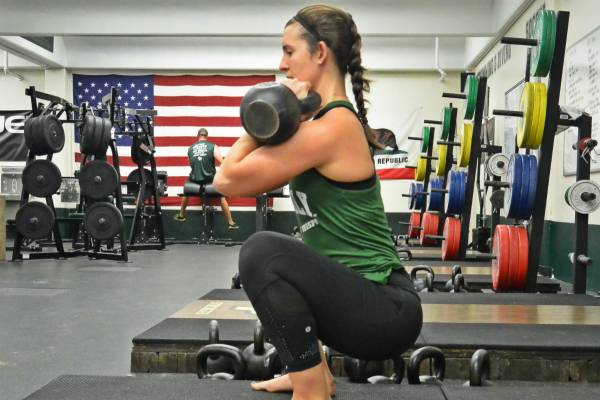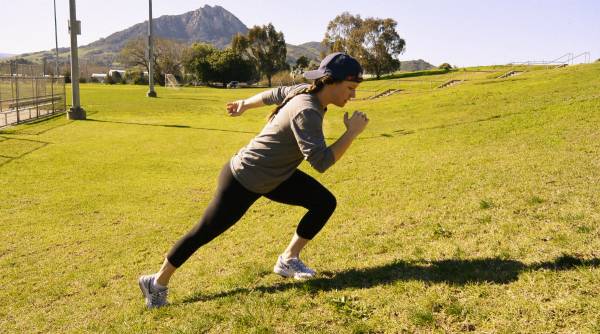After years and years of building athletes for competition, I’ve come to one distinct conclusion: sports coaches know how to build strong, muscular butts.
We never program for aesthetics, but at the end of the day, competitive athletes of all levels end up having some of the most rocking bodies around. From shredded midsections, to legs of granite, to the ever-so-sought-after bubble butt, if you want to look amazing at the beach, then you should seriously consider training like an athlete.
After years and years of building athletes for competition, I’ve come to one distinct conclusion: sports coaches know how to build strong, muscular butts.
We never program for aesthetics, but at the end of the day, competitive athletes of all levels end up having some of the most rocking bodies around. From shredded midsections, to legs of granite, to the ever-so-sought-after bubble butt, if you want to look amazing at the beach, then you should seriously consider training like an athlete.
Let’s do some brainstorming. Think of the last time you saw a track meet, either in person or on television. More specifically, think about the insane bodies of the sprinters. Or if you watch the CrossFit Games, there’s no way you can sit through an event and not see some of the best asses you’ve ever seen. What’s the common thread?
What are these groups, and others like them, doing to have such magnificent backsides?
The key to perfectly sculpted hindquarters is muscle .
Athletic Movements to Sculpt Your Posterior
The following is the recipe I use in my shop here at Cal Poly. No, I’m not trying to build big butts. I’m chasing function.
But without trying, we are also building strong, muscular rear ends. Here are a few of my favorite ideas and concepts for getting your ass where you want it.
Glute Bridges or Hip Thrusts
I would be doing Bret Contreras and his work a major disservice if I didn’t mention this first. I don’t know Bret personally, but I have read a ton of his articles on building the dream backside with the glute bridge.
Of course, the glute bridge is near the top of every list when programming for glute development.
Whether you are going directly off of the floor, using a bench, or utilizing one of Bret’s Hip Thruster units, the intention is to isolate the glutes entirely. I’ve used this for my sprinters and my position players in football with incredible results.
Particularly with “starts,” either out of blocks or from a 40-yard dash stance, the glute bridge shows its major value in the first big push in a sprint.
There’s one major technique piece that you need to understand. Because of our sitting culture, most of us have a degree of inefficient glute activation due to tight hip flexors. I see this as a literal epidemic with my younger athletes. If you feel this exercise primarily in your hamstrings, you have a problem.
One of the easiest ways to reassign the work is to pinch your buns together prior to lifting your hips up. This will usually redirect the responsibility back to the glutes and move the work out of the hamstrings. Also play with foot pressure.
Typically, the more pressure is directed toward the heels, the more you will feel the work move to your butt. I keep the volumes on this exercise high (in the 10-20 reps per set range).
Squats, Reverse Lunges, Pistols, and Step Ups
Range of motion is the biggest factor in making these exercises pay off. For your butt to fully participate, you have to get below parallel.
The standard for a countable rep in a CrossFit competition is “hip crease below the knee.” Whether or not you are a fan of CrossFit, one of the things they have gotten right is this rule. It’s a big reason why CrossFitters have some of the best asses in the world.
If you are using squats to build your butt and don’t get low, you’re wasting your time.
Additionally, if you are trying to zero in on the glutes, prying or driving the knees out (hip external rotation) will add layers of activation that will go directly to your backside.
Think spreading the floor out, or if you were standing on a big piece of paper, tear the paper from top to bottom with your feet.
Remember, it’s the sensation you are going after. You don’t want your feet to actually move. This will not only direct the work to the rear, but will also slightly distract the femoral head from the pelvis, creating more space in the hip to create greater levels of freedom to get lower.

If you aren’t squatting deep, you aren’t engaging your glutes the way you could.
Hinging Exercises
There are 100 reasons why athletes should do these movements, and nearly all of them apply to you.
All major hinging exercises bring the butt into play in a big way. Any time you hinge at the hip, the glutes take on a significant role in absorbing the work while acting as the stabilizer for the low back.
However, most people fail to feel the work and direct it where it belongs. Let me explain what I mean. Stop reading this, close your eyes, and with your mind alone feel your right knee cap. Don’t worry, I’ll wait.
Now do it again and feel the contours of the cap itself, the sensation of the back of the knee cap and where the patella tendon connects. Can you feel all those things?
Most of us zombie our way through our days and never feel the right knee cap, or any body part for that matter, in the way you just did. But you were able to develop a new awareness of that area of the body. When working the hinge exercises, you need to have complete awareness of your butt.
Your focus should not be what you are seeing in the mirror or the song you are listening to, but feeling every fiber of your ass working.
Most of these reps need to be performed with an intense contraction at the top of the movement, even if the weight alone isn’t enough to force it. A perfect example of this is the kettlebell swing. Most people snooze through their swings, and it makes me crazy.
The contraction your glutes experience should give you the feeling of cramping on every rep. This is where your intention needs to override everything else. Think, “I’m going to tear both butt cheeks off of the bone on this next rep.” Squeeze with everything you have.
Programming sets and reps for hinging movements can take on all kinds of looks.
For the good mornings and deadlift variations, because of the considerable loads you might attempt, we can work as high as the 20 reps and as low as an all-out single. For the kettlebell swing, keep your volume at 10 most of the time, occasionally working for 15-20 reps.
Olympic Weightlifting
The most beautiful way to combine the above activities is to do some Olympic lifting. Hinging and squatting are the name of the game for this style of training.
If you are looking for a strong, powerful midsection and want to pack muscle on your butt, this is a smart way to go.
The dynamic nature of Olympic weightlifting gives your butt serious exposure to heavy weights, consistent full range of motion work, and a perfect level of intensity.
There is one caveat though: Olympic weightlifting is very technical. Don’t venture into it until you have had some solid instruction.
Pay the money to get several sessions with someone who knows what they are doing so that you stay safe and get the most from this style of training.
Sprints and Stairs
Remember those track bodies we were talking about earlier? Those butts are not built in the weight room, they are constructed on the track. Sprinting is one of the best ways to stimulate not only the rear end but the entire lower body.
The nature of the activity can only be compared to heavy triples or single on a deadlift or squat. Most track athletes will run multiple sprints near max effort at each practice. Imagine how much thickness is being produced simply by running.
Hill sprints and stadium stairs are not just for athletes. In fact, they are as effective and likely considerably safer than flat ground sprinting.
I tend to worry about hamstring injuries in flat ground sprinting, but on a hill or stairs, the hamstrings stay protected. The climbing position forces the person to drive and dip into levels of intensity that are hard to produce in other exercises.
My recommendation is to buy a comfortable pair of soccer or football cleats and then find a hill that has your name written all over it.
Your degree of conditioning will dictate how many you do, but twenty trips up will get your heartrate up and get to the dark meat of your butt, regardless of your level of fitness. Remember, haul ass up the hill or stairs, no pun intended.

Hill sprints give you all the glute activation of flat sprints, with a little added safety for your hamstrings.
Sled Work
Sled work is hard, but the payoff in glute development cannot be overstated. Any of you who have done much sled work will attest, the burn from Prowler pushes is like no other.
Because of the position you are in, the hip stays in an angle and feeds the work to your backside. As you are pushing, take as full of steps in the driving phase as possible. And, as you will see in this piece a little later, go like hell. Nothing slow and soft. Go full out.
A couple of things to remember. First, programming typically revolves around how heavy you make the sled and distances. Be realistic in your choice of how far to go.
Gassing out early does nothing for you besides making you want to puke
Next, your hip flexors will typically light up during this work, so once you have finished, do some hip flexor stretching/opening to keep them from locking down and upsetting your low back.
If You Like What You See, Do What They Do
There you have it. If you want a backside that looks like the athletes you admire, these movements will help you get there:
- Glute bridge/hip thrust
- Squats, reverse lunges, pistols, and step ups
- Hinging exercises (deadlift variations, good mornings, kettlebell swings)
- Olympic lifts
- Sprints and stairs
- Sled work
Remember, doing things casually, picking weights that don’t challenge you, or performing half-assed reps simply to get the set done isn’t going to build what you want. You need intensity. And intensity isn’t just about yelling, getting hyped, and going until you black out.
Intensity has more to do with your determination to give a full effort to what you are about to do. It’s about having the courage to venture into places you have never been before.
This can be how heavy you go, or how many reps per set. It can even be your willingness to venture into new ranges of motion on a given exercise. You have to be prepared to be uncomfortable and make up your mind to grind from set to set.
Unless you picked the perfect parents, most of us need to do some work to make our jeans fit just right. Athletes walk around with strong, full backsides that make most of us jealous. It makes sense to look into what they are doing and replicate their programs.
More Tips for a Beautiful Backside:
- Ladies: 3 Gym-Friendly Exercises to Develop Your Glutes
- Butt-ology 101: How to Enhance Your Gluteal Muscles
- The Do It All Exercise to Go From Dead Butt to Active Arse
Pictures courtesy of Chris Holder.






